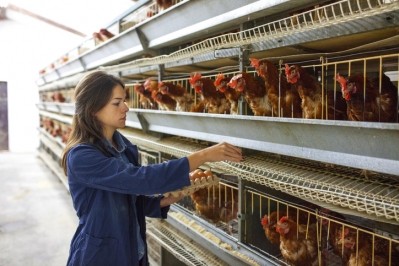Special Edition: Novel Proteins
Brassica byproducts provide alternative protein source for layers

Researchers from the University of Alberta and Alberta Agriculture and Forestry explored the use of Brassica napus and Brassica juncea extruded-expeller cake and solvent-extracted meal in the diets of laying hens. The study was published in the journal Poultry Science.
“Two experiments (Exp. 1 and Exp. 2) were therefore conducted to compare feeding relatively high dietary inclusions of B. napus and B. juncea extruded-expelled cakes and solvent-extracted meals on performance, egg quality, and nutrient digestibility in laying hens,” the researchers said.
“In Exp. 1, we sought to test the hypothesis that hen productivity and egg quality would not differ among hens fed diets containing 20% of either B. napus and B. juncea extruded-expelled cakes and solvent-extracted meals compared with a barley/wheat-based diet containing no Brassica co-products,” they added. “In Exp. 2, we tested the hypothesis that nutrient digestibility would not differ for B. napus or B. juncea extruded-expelled cakes or solvent-extracted meals fed to laying hens.”
The authors found that in the first feeding trial there was no change to hen laying percentage or bodyweight throughout the 36-week period. However, feed consumption dropped 3.5g/day for layers receiving a diet with 20% solvent-extracted B. juncea meal compared to the birds on the control diet.
The egg: feed ratio dropped 14mg egg/g of feed for layers on the diet with B. juncea expeller cake, they said. Birds eating the feed with B. napus meal laid heavier eggs than birds on the control diet, while birds on all other diets with Brassica ingredients had lighter eggs than control group birds.
Birds on the Brassica-inclusive diets had a higher proportion of monounsaturated fatty acids and birds on the B. juncea diets had higher levels of select fatty acids, they said.
However, in the second feeding trial, the researchers noted that adding Brassica ingredients to the diet lowered digestibility of dry matter, gross energy and crude protein compared to the use of a basal diet. The digestibility of several important amino acids, except tryptophan, also fell for Brassica diets.
“The present study demonstrated that Brassica cakes and meals can be fed to laying hens at dietary inclusions up to 20% without adverse effects on hen productivity or egg quality. It was further demonstrated that while the AID [apparent ileal digestibility] of AA in all co-products was moderately high (>70%), further investigation is required to relate pre-press quality indicators in the seed to nutrient digestibility of the post-press co-products that result.”
Interest, challenges to canola use in poultry feed
Although solvent-extracted canola – Brassica napus – meal provides a nutritious and cheap dietary protein ingredient for laying hens, the use of canola meal is limited by fiber content and antinutritional factors, the authors commented.
Glucosinolates are one antinutritional element in the meal that can lower feed intake and alter metabolism, they said. “Solvent-extracted meal produced from Indian mustard (Brassica juncea), which is closely related to B. napus, has greater energy value and protein content and lower fiber content compared with canola, but greater total glucosinolate content."
However, it was recently noted that adding up to 20% canola meal or B. juncea meal had similar results to use of soybean meal for laying hen performance and egg quality, they said. But negative effects from feeding 20% B. juncea meal to laying hens have been noted.
Why test new canola co-products in layer hen feed?
Farm-scale canola crush has been increasing in western Canada, wrote the researchers. The process provides an alternative marketing option for seed with sub-optimal quality, they said.
The oilseed cake generated, which often has 10 to 15% remaining oil, is considered an alternative to solvent-extracted oilseed meal, they said. However, there is little known about the use of the feed ingredient in poultry diets, the authors commented.
“Further, there is no information available regarding the variation in nutrient content of small-scale crushing plant co-products comparable to the information available for commercially-available solvent-extracted co-products."
Adding higher levels of extruder-expelled B. juncea cake has been linked to depressed feed intake in pigs based on the higher glucosinolate levels, they said. But, chickens have a lower sensitivity to the antinutritional element.
“High temperature achieved during extrusion could inactivate intrinsic thioglucosidase enzymes in the seed that catalyze the hydrolysis of glucosinolates into less palatable isothiocyanate and nitrile metabolites."
Extrusion may improve nutrient digestibility as has been noted with other high-fiber, high-protein feed ingredient, they added.
Previous research has not compared the feed value of B. juncea and B. napus co-products to large-scale solvent extracted ingredients in laying hen diets, the researchers said.
Feeding trial details
In an initial feeding trial, 120 laying hens received one of five diets for 36 weeks, the authors reported.
The diets included a control with no Brassica-based co-products and diets with either 20% B. napus or B. juncea extruded-expeller cakes (NC, JC) or solvent-extracted meals (NM, JM), they said.
“Test diets were fed over two production phases (weeks 1 to 24 and weeks 25 to 36 of lay, respectively) and were formulated to provide similar levels of AME, crude fat, CP and digestible Lys to AME ratio."
Hens were weighed at the start of the feeding trial and every four weeks throughout the feeding trial. Feed disappearance was calculated along with average egg weight and the number of eggs produced was recorded.
A selection of eggs produced from days 68 through 70 was broken to assess the wet weight of shell, albumen and yolk along with the proportion of each element relative to the weight of the whole egg, the researchers said. Eggs were collected on day 150 to assess specific gravity, albumen height, pH and establish Haugh Units.
Eggs generated during week 13 of the trial were collected for fatty acid analysis.
In the second trial, 240 hens received one of the five diets for seven days after a seven-day period where all birds received a control diet, the researchers said. Bird manure was collected for analysis on day 13 of the feeding trial.
All birds were harvested on day 15 and digesta was collected, they said. The intention behind the trial was to explore dry matter, gross energy, crude protein and amino acid (AA) retention and digestibility.
The diets included a control with no Brassica ingredient and diets with 30% B. napus cake or meal or B. juncea cake or meal.
Results
In the first trial there was no influence on the rate of lay or hen body weight, the researchers said. Hens on the control diet at less than those on the brassica-containing diets, but only for the first 8 weeks of the feeding period.
Overall, average daily feed intake was smallest for hens receiving the JM diet compared to control, they said. Layers on the JC diet were less efficient than birds on the control feed.
“Overall, eggs from hens fed the NM diet were heavier than those from controls. Feeding of NC, JM, or JC resulted in lighter eggs than those from layers fed the control diet. The same pattern was seen for the effect of diet expressed as egg mass production (g of egg/hen/day).”
Yolk pH was lower in eggs from birds on the supplemented diets and color measurements were altered for non-control group birds, they said. Egg albumen weight was highest in eggs from chickens on the NM diet and lowest for those on the JC diet.
“Eggs from hens fed NC and JM contained less fat than eggs from controls. Eggs from controls had greater proportions of both saturated and polyunsaturated fatty acids compared with eggs from layers fed Brassica diets.”
Eggs from birds on the Brassica diets had increased proportions of monounsaturated fatty acids.
“Eggs from hens fed diets including B. juncea had relatively greater proportions of C18:3 (n3) compared with those of layers fed diets including B. napus.”
“We concluded that feeding B. napus and B. juncea extruded-expelled cakes and solvent-extracted meal at 20% of diets to hens supported acceptable lay performance and egg quality over a 36 wk production cycle,” they said.
In the second trial, diets with Brassica tended to lower the apparent total tract digestibility (ATTD) of dry matter and gross energy along with the apparent ileal digestibility (AID) of crude protein, the researchers said.
“The AID of most essential AA, with the exception of tryptophan, was reduced feeding Brassica diets compared with controls,” they said. “The AID of tryptophan was increased feeding Brassica diets compared with controls.”
Source: Poultry Science
DOI: doi.org/10.3382/ps/pez501
Title: Brassica napus and Brassica juncea extruded-expelled cake and solvent-extracted meal as feedstuffs for laying hens: Lay performance, egg quality, and nutrient digestibility
Authors: M.A. Oryschak, M.N. Smit, E. Beltranena













